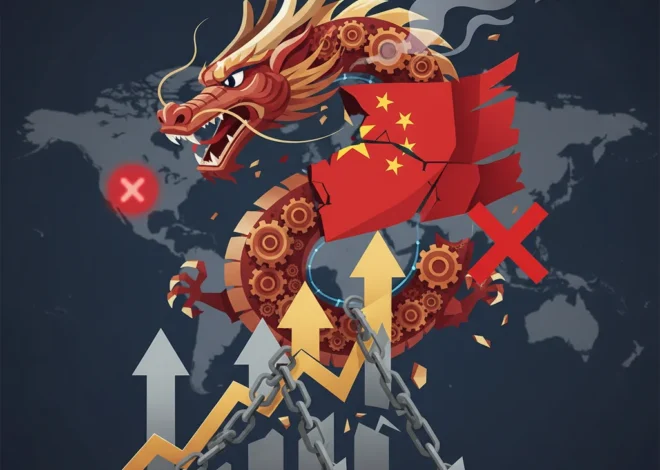
The Dragon and the Eagle: Deconstructing the High-Stakes US-China Economic Standoff
The global economy often feels like a massive, intricate machine. When its two largest gears—the United States and China—grind against each other, the entire mechanism shudders. For years, the world watched as Washington and Beijing engaged in a tense economic conflict, a saga of tit-for-tat tariffs, fragile truces, and profound market turmoil. This escalating confrontation culminated in high-stakes meetings between US President Donald Trump and Chinese leader Xi Jinping, moments where the future of global trade and finance seemed to hang in the balance.
But how did we get here? This wasn’t a sudden storm but a hurricane that had been brewing for decades. To understand the significance of these summits, we must first trace the path of discord, from the initial grievances to the full-blown economic conflict that reshaped global supply chains and rattled the stock market. This is the story of a trade war that was always about more than just trade.
The Seeds of Conflict: Decades of Imbalance
The foundation of the US-China trade war rests on long-standing American grievances. For years, successive US administrations raised concerns over Chinese economic practices, which they argued were unfair and predatory. The core issues included:
- Intellectual Property (IP) Theft: US officials alleged that Chinese entities systematically stole American IP worth hundreds of billions of dollars annually through cyber-espionage and other means.
- Forced Technology Transfer: American companies seeking to operate in China were often compelled to enter joint ventures and transfer their proprietary technology to Chinese partners, a practice seen as a toll for market access.
- The Trade Deficit: The most visible symbol of the economic imbalance was the massive trade deficit. In 2017, the year before the first tariffs were imposed, the U.S. goods trade deficit with China stood at a staggering $375 billion, a figure that became a central focus of the Trump administration’s “America First” agenda.
These issues, combined with concerns about state-subsidized Chinese enterprises and market access barriers, created a fertile ground for a more confrontational approach. The goal from the US perspective was not just to rebalance trade figures but to force structural changes in China’s state-led economy.
The £2.1 Billion Breach: How the Jaguar Land Rover Hack Rewrote the Rules of Financial Risk
The Escalation Ladder: A Timeline of Tit-for-Tat Tariffs
What began as targeted measures in early 2018 quickly spiraled into an all-out economic conflict. Each move by one side was met with a swift and often symmetrical retaliation from the other, creating a cycle of escalation that sent shockwaves through the global trading system. The timeline below illustrates the major salvos in this tit-for-tat war.
| Date | U.S. Action | China’s Retaliation |
|---|---|---|
| January 2018 | Tariffs on solar panels and washing machines. | Launched anti-dumping investigations into U.S. sorghum. |
| March 2018 | Announced 25% tariff on steel and 10% on aluminum globally. | Imposed tariffs on $3 billion of U.S. products, including pork and fruit. |
| July 2018 | 25% tariffs on $34 billion of Chinese goods (machinery, electronics). | Immediately imposed 25% tariffs on $34 billion of U.S. goods (soybeans, automobiles). |
| August 2018 | 25% tariffs on an additional $16 billion of Chinese goods. | Matched with 25% tariffs on an additional $16 billion of U.S. goods. |
| September 2018 | 10% tariffs on $200 billion of Chinese goods, set to rise to 25%. | Retaliatory tariffs on $60 billion of U.S. goods. |
| May 2019 | Increased tariffs on the $200 billion tranche from 10% to 25%. | Announced tariff hikes on the $60 billion list of U.S. goods. |
This relentless escalation had a profound impact on the global economy. It disrupted deeply integrated supply chains, forcing businesses to re-evaluate their manufacturing footprints—a trend that gave rise to the “China Plus One” strategy. For investors, the period was marked by extreme volatility, with the stock market swinging wildly on every tweet, announcement, and rumor related to the trade negotiations.
Economic Shockwaves and the Tech Cold War
The impact of the tariffs was not confined to balance sheets; it was felt across Main Street and in the heart of Silicon Valley. American farmers, particularly soybean growers, saw their largest export market evaporate overnight as China retaliated. Consumers began facing higher prices on everyday goods, and businesses struggled with uncertainty and rising input costs. The conflict exposed the vulnerabilities of a hyper-globalized economy.
Perhaps more significantly, the trade dispute morphed into a broader “Tech Cold War.” The battle was no longer just about soybeans and steel but about who would dominate the technologies of the future—5G, artificial intelligence (AI), and semiconductors. The U.S. administration took direct action against Chinese tech giants like Huawei and ZTE, citing national security risks. Placing Huawei on the “Entity List” effectively cut it off from crucial American technology, including Google’s Android operating system and chips from U.S. semiconductor firms. This move highlighted a new front in the rivalry, one centered on technological and, by extension, economic dominance. This tech schism has profound implications for everything from banking infrastructure to the future of financial technology (fintech), as nations are now incentivized to develop parallel, non-interoperable tech ecosystems to reduce strategic dependencies.
The £2.1 Billion Keyboard Stroke: How a Cyber Attack Became the UK's Costliest Financial Disaster
This technological decoupling is a complex challenge. While it may spur domestic innovation, it also risks fracturing the global internet and slowing down technological progress. For the world of finance, it raises questions about the future of cross-border payment systems and the potential for competing digital currency blocs, perhaps even leveraging blockchain technology to create alternative financial rails immune to traditional sanctions. According to a report by the U.S. Chamber of Commerce, a full decoupling from China could cost the U.S. economy hundreds of billions of dollars, demonstrating the immense economic stakes involved.
At the Negotiating Table: A High-Stakes Game of Chicken
This backdrop of economic pain and strategic rivalry is what made meetings between Trump and Xi so critical. These summits were not just photo-ops; they were intense negotiations aimed at pulling the world’s two largest economies back from the brink. The core sticking points were formidable:
- U.S. Demands: Washington sought not only the purchase of more American goods but also fundamental, verifiable, and enforceable structural changes to China’s economy. This included ending IP theft, stopping forced technology transfers, and reducing subsidies to state-owned enterprises.
- China’s Demands: Beijing insisted that any deal must be “equal and mutually beneficial,” demanding the complete removal of all punitive tariffs as a precondition. They viewed the U.S. demands as an infringement on their national sovereignty and right to develop their economy as they see fit.
The negotiations often resulted in temporary truces, such as the “Phase One” deal signed in January 2020. This agreement paused the escalating tariff war, and China committed to purchasing an additional $200 billion in U.S. goods and services over two years, along with strengthening IP protections. However, many analysts viewed it as a ceasefire rather than a peace treaty, as it left the most challenging structural issues unresolved for a “Phase Two” that never materialized.
Conclusion: A New Paradigm for the Global Economy
The Trump-Xi summits and the trade war they sought to contain were more than just a chapter in economic history; they marked a fundamental shift in the US-China relationship and the global economic order. The conflict moved the dynamic from one of strategic cooperation to one of outright strategic competition. The era of prioritizing economic engagement above all else has given way to a new paradigm where national security, technological supremacy, and economic resilience are paramount.
For business leaders, finance professionals, and investors, the lessons are clear. The interconnected global economy is now layered with significant geopolitical fault lines. Supply chain diversification, robust risk management, and a keen understanding of international economics are no longer just best practices—they are survival tools. As the two giants continue to navigate their complex rivalry, the shockwaves will continue to be felt across every sector, reminding us that in the 21st century, the worlds of finance, technology, and geopolitics are inextricably linked.


